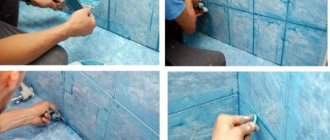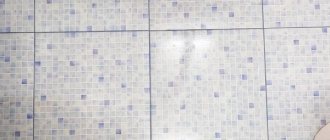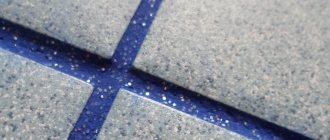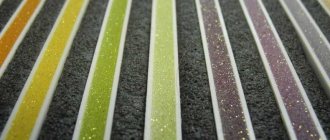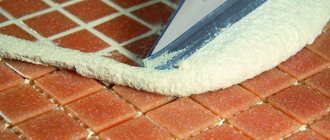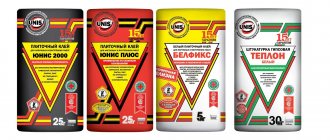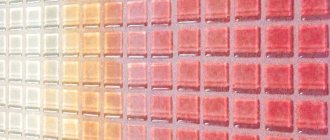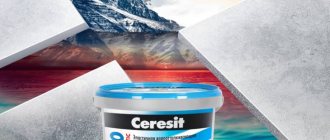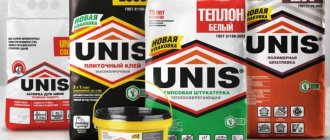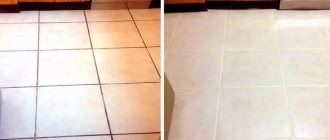When finishing tiling, it is necessary to grout the joints between the tiles. This stage includes work to eliminate some aesthetic defects in the masonry, strengthen the sealing of the space between the material, prevent foreign objects from getting under the tiles, ensure strength, extend the service life of the coating and complete the design appearance. It will be necessary to calculate the consumption of grout for tile joints per 1 m2 in order to purchase the necessary building materials in sufficient quantities or, conversely, without unnecessary surpluses. To do this, you can use an online calculator, get professional advice from a hardware store salesperson, or do it yourself.
Calculation of the volume of the fugue
- Linear dimensions of tiles: small tiles have a long seam.
- Depth and width of the seam: the solution should fill the entire space.
- The density of the mixture depends on the properties of the grout composition.
- The degree of complexity of the work - in some places you will need more solution to hide unevenness.
To correctly calculate the volume of a substance, you need to find out the composition of the mixture. There are quite a lot of grouts with different properties, each designed for specific conditions of use. Accordingly, the consumption will depend on the type of material.
Ways to save
Despite the established consumption standards, you can save money by grouting ceramic tiles. Below are some useful tips for this:
- Carry out high-quality preparation of the base for laying tiles. A smooth surface without flaws or deformations significantly reduces consumption.
- It is better to knead dry fugue by hand using a small trowel. When using electric equipment and a construction mixer, a lot remains on the mixer and the walls of the container.
- Prepare the material in small portions so that it does not have time to deteriorate (dry out in the container). Dry residue cannot be reused.
- The use of a construction syringe or gun significantly reduces the fugue consumption.
Basic properties of tile grout
- Softness and flexibility of grout components. When applied, high-quality material does not spread or bubble. For some brands, the plasticity properties remain after drying.
- The strength of the seam after drying. It should not crumble or crack.
- Color fastness means maintaining the shade after the grout mixture dries.
- Water-repellent properties are an important indicator of the quality of a substance. Tile is used mainly in rooms with high humidity.
Requirements for the placeholder
The quality of the seam and the durability of its service depend not only on how well the groove is filled, but also on the characteristics of the grout itself.
A good product must meet several characteristics:
Elasticity. When applied, high-quality solutions should fit well between the tiles
It is important that the consistency of the product is not thick or liquid. Experts recommend giving preference to grouts that remain plastic even after hardening.
They easily absorb the loads that occur during thermal expansion of the tiles, which leads to a narrowing or widening of the gap. Strength. A good grout should retain its structure after hardening. If the material crumbles and falls out, then its use will not solve the problem and over time it will have to be completely replaced. Waterproof. High-quality products are characterized by high water repellency. If the solutions allow liquid to pass through, then they will not be able to properly protect the wall, which may become moldy.
Linear dimensions of the facing element
It is worth calculating the required amount of material, knowing what size the tiles will be laid. The amount of grout is directly related to the dimensions of the tile - the smaller the size, the more grout mixture will be needed.
Construction stores offer a huge variety of shapes and sizes of facing materials to choose from. When using mosaic tiles, especially round ones, the cost of grouting will increase significantly.
To avoid a large amount of waste, craftsmen choose cladding sizes that are multiples of the floor or wall surface.
Application area
For which surfaces can the epoxy composition Litokol be used, consider:
- For covering surfaces in rooms with high humidity. These are bathtubs, showers, saunas, swimming pools.
The photo shows epoxy grout for a sauna. - When treating kitchen work surfaces, including the apron above the work area and the sink.
- For cladding and finishing of balconies and terraces. Attention: this method is suitable for those areas where the temperature in winter does not drop below minus 20 degrees. If it gets colder, the grout may not hold up.
- Floors with a heating system are also suitable for covering them with slabs with Litokol grout.
- For finishing cheese factories, mud baths, industrial complexes and other premises.
But what kind of grout for floor tiles in the bathroom is most often used is described in this article.
This article will help you understand which moisture-resistant grout for joints is the best and what criteria should be used to choose it.
How to use grout for tiles in a Ceresit bathroom and how exactly to use it is described here in the article: https://resforbuild.ru/sypuchie-materialy/zatirka/kakaya-zatirka-dlya-plitki-v-vannoj-luchshe.html
You may also be interested in learning how ceresit ce 33 super grout is used.
Intertile gaps
The average distances between tiles are: for floors – 3-5mm, for walls – 2-3mm (in practice they reach up to 3cm).
Sometimes an increased seam width is the result of a design idea. For budget cladding, the increased gap is necessary to equalize the difference in tile sizes.
The gap is expanded under certain circumstances: seismic activity, new construction. The enlarged seam protects the tile from cracking when deformed. At the same time, grout consumption increases.
Materials used
To grout the seams of laid tiled cladding, materials from the manufacturers Litokol and Ceresit of group CE-40, CE 33 are used. Grouting building materials are selected taking into account the type of cladding, the width of the joints between the tiles and future operating conditions.
Litokol
Cement mixtures Litokol for tiles are a popular type of grout. They can be used for internal and external cladding work - they do not lose color, abrasion or the influence of aggressive detergents, and are characterized by special strength and a long service life. The Litokol company presents compositions for filling both narrow and wide mosaic joints, for floor and wall masonry. To get started, cement-based grout can be easily dissolved with water or latex, following the instructions for use.
Litokol epoxy grout, unlike cement grout, ideally suits any aesthetic objectives when facing with marble, smalt, or for mosaics. Its color palette is very diverse - a large number of shades, there are options with original decorative effects - “metallic”, “bronze”, “silver”, “mother of pearl”. The color remains unchanged for the entire service life of the tile covering. You can choose a transparent type of grout, which will help when creating glass mosaic panels and structures with built-in lighting. Two-component epoxy grout “Litokol” forms a very strong and dense joint that can be subjected to serious loads. The seam joint does not absorb dirt, rust, does not crack, and retains all its original characteristics over time. Grouts based on epoxy resin resist the formation of fungi, mechanical damage, exposure to sunlight, and aggressive chemicals. They are moisture resistant and can withstand frost and high temperatures in saunas without problems.
Epoxy tile grout from Litokol is characterized by increased viscosity, which requires a certain level of professionalism and accuracy in work. After the reaction of the mixed components of the epoxy mixture is complete, it becomes chemically inert and becomes absolutely harmless to the environment and humans. Its fundamental difference from cement-containing compositions is its special demands in maintaining the proportions of ingredients when preparing the working mixture.
Polyurethane products are an innovative grouting material based on an aqueous dispersion of polyurethane resins. This composition provides a tight and super-elastic joint, necessary for the manufacture of heated tile floors and substrates subject to increased vibration or deformation. Litokol polyurethane mixtures are very easy to use. They are completely prepared for use, unlike epoxy grout, and do not require pre-mixing of ingredients.
One of the types of Litokol grout is Epoxystuk X-90 epoxy grout, the consumption of which can be found in the table.
| Tile format, cm | Seam width, mm | Consumption, kg/m2 |
| 12x24x1.2 25x25x1.2 | 5-8-10 | 1,16-1,86-2,33 0,74-1,19-1,49 |
| 10x10x0.6 15x15x0.6 | 3-4-6 | 0,56-0,74-1,12 0,37-0,50-0,74 |
| 15x20-0.6 25x25x1.2 | 3-4-6-8 | 0,33-0,43-0,65-0,87 0,45-0,60-0,89-1,19 |
| 25x33x0.8 33x33x1 | 4-8-10 | 0,35-0,70-0,87 0,38-0,75-0,94 |
| 30x45x1 45x45x1.2 | 4-10 | 0,34-0,86 0,33-0,83 |
| 50x50x1.2 60x60x1.2 | 6-10 | 0,45-0,74 0,37-0,62 |
Ceresit
Elastic water-repellent grout Ceresit CE-40 is intended for grouting tile joints up to 10 mm wide inside and outside buildings, as well as for all types of tiles. Due to its high elastic properties, CE-40 is more often used in cladding work on moving deformable bases, including heated floors, for joints of OSB boards, and plasterboard sheets. Humidity does not penetrate inside the Ceresit CE-40 grout, but rolls down its surface. Has an antifungal effect. Available in 32 shades, including white. CE-40 has color fastness and does not fade. Resistant to dirt, easy to clean, highly resistant to abrasion, frost-resistant. The surface of the seam is perfectly smooth and beautiful. Grout CE-40 is environmentally friendly for humans and the environment. The choice of consumption of Ceresite grout is also carried out according to the formula.
In order not to make a mistake when determining the consumption of Ceresit CE-33 grout, you should use the table.
| Size of laid material, cm | Seam width, mm | Grout consumption, kg/m2 |
| 5x5 | 2 | 0,5 |
| 5x5 | 3 | 0,7 |
| 10x10 | 2 | 0,4 |
| 10x20 | 3 | 0,4 |
| 15x15 | 3 | 0,4 |
| 20x20 | 5 | 0,5 |
Ceresit CE-33 is a grout of different colors with antifungal properties for finishing joints between tiles up to 5 mm wide. These are primarily mosaics and small tiled elements (friezes, borders).
CE-33 is produced in dry powder form, mixed with water. You should carefully follow the instructions for preparing the CE-33 mixture, since excess water or the formation of lumps can impair the properties of the grout. The solution can be used for an hour. 29 colors CE-33 allows you to create an excellent smooth base for small fragments. At the same time, Ceresit CE-33 is not inferior in water resistance, is not afraid of fungi and mold, can withstand up to 50 frost resistance cycles, is suitable for external and internal use, and is non-toxic.
Density of grout mixture
The density of the substance is written on the packaging of the original fugue. The average value is 1.5 – 1.7 kg/dm3.
Seam width
Nowadays, tiles come in a variety of sizes, ranging from 10 cm to 60 cm, and this factor is not unimportant when calculating how much fugue will cost per square meter, as we will write below.
More details in the table. Dimensions of tiles in cm Length M m/m2
Seam width
Most often, it is equal to the width of the plastic crosses that we laid during the installation of the tiles.
READ MORE: Tile panels for the kitchen, options for decorating the kitchen using ceramic tiles Paintings from tiles in the interior
But sometimes, depending on the design decision, the width of this element reaches 20-30 mm.
The grout is selected individually in each case. But, nevertheless, we will need these numbers in order to find out the consumption coefficient.
| Dimensions of tiles in cm | Length M m/m2 |
| 10x10 | 19,5 |
| 10x15 | 16,2 |
| 10x20 | 14,5 |
| 11.5x20 | 12,5 |
| 15x15 | 13,4 |
| 20x20 | 11,5 |
| 20x30 | 9,9 |
| 25x25 | 7,9 |
| 30x30 | 6,6 |
| 40x40 | 5,0 |
| 60x60 | 3,3 |
Formula for calculating grout for tiles per 1 m2
The fugue consumption can be calculated as follows:
- Р3 = МхК, where РЗ – mass of the mixture,
- M is the length of the seam and K is the consumption indicator.
Gap length indicator:
- M = (A+B)/AxB, A and B, respectively, the length and width of the processed space.
- K = W×D×R, W – width,
- G – depth,
- P is the density of the substance.
To the resulting value you need to add 10% of the raw material.
On the packaging, the manufacturer indicates theoretical consumption rates for ideal installation, but it is impossible to foresee all the nuances that arise in practice, so it is worth calculating the consumption of the building mixture yourself.
You can use tables to calculate the volume of grout, but they only give the main dimensions of the tile.
Recommendations for selection
The information above is enough to choose the right material for jointing gaps in tile cladding.
- For dry areas of the wall (kitchen splashback, bathroom, glazed balcony), a regular powdered cement mixture is sufficient.
- Rooms with damp conditions, where tiles are constantly in contact with water or steam, are recommended to be jointed with polyurethane or latex compounds. Epoxy will also work.
- Expansion joints and troubled surfaces are sealed with latex, polyurethane or furan fugue.
- For heated floors, it is advisable to use a polyurethane or latex mixture - a cement fugue is too hard and may crack.
- Depending on the width of the seam, the following are purchased:
- for gaps up to 3 mm wide - plastic compositions without mineral fillers (sand);
- gaps of 4-6 mm - any mixtures filled with sand of the finest fraction;
- wide paths from 10 to 20 mm will require a cement fugue with the addition of plasticizers and coarse quartz sand.
- Tile with a glossy surface is afraid of compositions with sand. Here you need a latex or polyurethane mixture. You can also use finely ground cement without mineral filler.
- Mosaic and glass tiles are best jointed with epoxy.
- For tiles with a textured surface, it is advisable to buy cement-sand grout. Ready-made mixtures lead to excessive consumption of material - a lot of it remains on the surface of the cladding.
Everything is clear here. The biggest problems arise when you need to decide how to choose a tile grout based on color.
What grout color to choose
The simplest solution in this situation is to recommend that consumers buy fugu according to their taste. But there are several design rules that will help you navigate among multi-color mixtures.
- A light (gray or beige) shade unifies the pattern on the tiles, simultaneously visually increasing the size of the room.
- It is better to grout floor tiles with darker mixtures - dirt is less visible.
- Dark-colored joints highlight the color and texture of the tile well.
- Walls with plain tiles look good with a fugue 1-2 colors lighter or darker than the tiles.
- Patchwork tiles are best grouted with transparent compounds.
- Multicolor panels will receive even greater expressiveness from the “chameleon” mixture.
- The contrasting shade of the seam will highlight the color scheme of the cladding.
A special program located here will help you choose the color of grout to match the tiles.
Factors affecting grout consumption
The fugue is available in two types:
- Dry mixture of components - diluted in water in small portions before use.
- Ready-to-use solution. Use immediately after opening the container until the components have hardened.
Jointer tools
The following tools are used in jointing work:
- different types of spatulas, which are used to clean surfaces of glue, apply and distribute the fugue, and smooth seams;
- containers for water and mixing the mixture;
- kneading spatula;
- foam sponge;
- gloves;
- pliers;
- sandpaper.
The solution is prepared in small portions; its consistency should resemble thick sour cream. Remove the crosses and remaining glue between the tiles from the wall. Using a rubber spatula, carefully fill the space between the tiles with a fugue. Excess solution is immediately removed with a foam sponge. The filled joints are left to dry and then polished with fine sandpaper.
Photo of the best grout for tiles
Common mistakes when grouting joints and how to avoid them
Typical mistakes do not allow you to obtain high-quality and beautiful cladding. Therefore, it is worth familiarizing yourself with common cases when the wrong approach harms your work. Grouting on dirty walls is unacceptable. Be sure to remove any remaining glue. The rule also applies to inventory. It is allowed to work only with clean tools. It is better to have several different spatulas, separate for grout and glue.
First remove the solution from the seams. It is impossible to apply grout without such a procedure. Before applying a new grout layer, the old one is removed. It is a mistake to mix the mixture with a drill. The tool speeds up the process, but degrades quality due to air entry. Metal spatulas should be avoided. A common mistake that occurs frequently is mixing a large amount of mixture at once. It is better to knead in portions, processing a small area of lining.
Grouting is a simple process if you take it seriously and study the process carefully. Careful adherence to the recommendations will allow you to obtain high-quality, clean and beautiful cladding.
